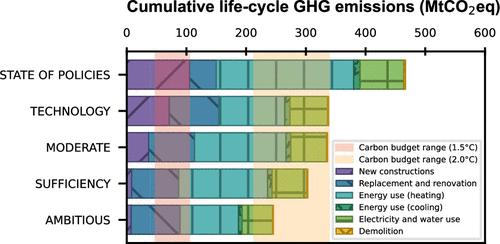奥地利建筑库存的未来生命周期温室气体排放情景:系统方法
IF 11.3
1区 环境科学与生态学
Q1 ENGINEERING, ENVIRONMENTAL
引用次数: 0
摘要
建筑存量模型可用于确定不超过剩余碳预算的轨迹,并支持基于科学的路径。基于系统思维的前瞻性生命周期评估领域采用了一种系统的方法,为考虑生命周期温室气体排放的奥地利建筑开发方案。确定了模型的影响参数;它们的相互作用是分类的;采用定量的未来假设;并创建了五个场景叙述。2023年至2050年最大减排90%。相比之下,保持现行政策不变只能使排放量减少66%。另外三种情景可在2050年前实现84%至86%的减排,使用人均等额方法,这可能与2°C碳预算相适应。这些场景代表了不同的社会选择,这些选择基于雄心勃勃的充足性(例如,行为改变),技术措施(例如,行业变革),或两者兼而有之,而所有参与者的努力较少。为了确保奥地利在剩余的碳预算范围内做出贡献,政策制定者被敦促系统地、迅速地将充足性纳入其政策,并对二氧化碳去除技术进行必要的投资。本文章由计算机程序翻译,如有差异,请以英文原文为准。

Future Life-Cycle Greenhouse Gas Emission Scenarios for the Austrian Building Stock: A Systematic Approach
Building stock modeling can be used to identify trajectories that do not exceed the remaining carbon budget and support science-based pathways. A systematic approach is used from the field of prospective life-cycle assessment, which is based on systems thinking, to develop scenarios for the Austrian building stock that consider life-cycle greenhouse gas emissions. The influential parameters of the model are identified; their interactions are classified; quantitative future assumptions are adopted; and five scenario narratives are created. A maximum emission reduction of 90% from 2023 to 2050 is revealed. In comparison, leaving current policies in place would lead to a trajectory that reduces emissions by only 66%. Three additional scenarios achieve emission reductions between 84 and 86% by 2050, which may be compatible with the 2 °C carbon budget using an equal-per-capita approach. These scenarios represent different societal choices based on ambitious sufficiency (e.g., behavioral change), technological measures (e.g., a change in the industry), or both, with less effort from all actors. To ensure that Austria contributes to staying within the remaining carbon budget, policy makers are urged to systematically and quickly incorporate sufficiency into their policies and enable the necessary investments in carbon dioxide removal technologies.
求助全文
通过发布文献求助,成功后即可免费获取论文全文。
去求助
来源期刊

环境科学与技术
环境科学-工程:环境
CiteScore
17.50
自引率
9.60%
发文量
12359
审稿时长
2.8 months
期刊介绍:
Environmental Science & Technology (ES&T) is a co-sponsored academic and technical magazine by the Hubei Provincial Environmental Protection Bureau and the Hubei Provincial Academy of Environmental Sciences.
Environmental Science & Technology (ES&T) holds the status of Chinese core journals, scientific papers source journals of China, Chinese Science Citation Database source journals, and Chinese Academic Journal Comprehensive Evaluation Database source journals. This publication focuses on the academic field of environmental protection, featuring articles related to environmental protection and technical advancements.
 求助内容:
求助内容: 应助结果提醒方式:
应助结果提醒方式:


